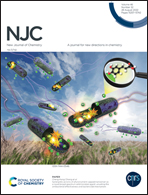Host–guest complexation of APP+ with cucurbit[7]uril. Theoretical and experimental studies on the supramolecular inhibition of its cytotoxicity on SERT†
Abstract
The supramolecular binding behavior of the fluorescent compound 4-(4-(dimethylamino)phenyl)-1-methylpyridinium (APP+) and CB[7] was investigated in aqueous solution by nuclear magnetic resonance, isothermal titration calorimetry, high-resolution mass spectrometry, UV-Vis spectroscopy, steady-state and time-resolved fluorescence spectroscopy, and molecular modelling. APP+ binds to CB[7] with a binding constant (Kb) of (2.6 ± 0.3) × 106 M−1, with a 1 : 1 inclusion stoichiometry. APP+ was shown to be cytotoxic towards HEK293 cells expressing human serotonin transporter (hSERT), with an IC50 of 0.146 μM. Meanwhile, this compound did not show any cytotoxicity towards wild type HEK293 cells. Moreover, cell uptake through the hSERT was consistent with the inhibition of cytotoxicity by fluoxetine, which binds tightly to the transporter. Interestingly, cytotoxicity could also be inhibited by the pre-incubation treatment of the cells with CB[7] suggesting a protective role for this macrocycle due to the complexation of APP+. Finally, molecular modelling studies suggest a blocker effect generated by the CB[7]/APP+ complex on SERT preventing the entrance of APP+.
![Graphical abstract: Host–guest complexation of APP+ with cucurbit[7]uril. Theoretical and experimental studies on the supramolecular inhibition of its cytotoxicity on SERT](/en/Image/Get?imageInfo.ImageType=GA&imageInfo.ImageIdentifier.ManuscriptID=D2NJ01963A&imageInfo.ImageIdentifier.Year=2022)


 Please wait while we load your content...
Please wait while we load your content...